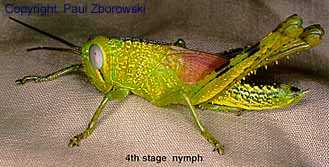Nymph description 9 of 15

Distribution

Nymph Description: Colour is very variable. Early instars tend to be green to brown with variable strong dark patterns. Yellow and orange and pink patches appear later with wing buds often pink. In profile the body has the head held very high and the line of the top of the body concave, particularly in early instars. The rear legs are long and visibly thinner than in most nymphs and have two prominent bands on the femur. The oblong eye is vertical in profile with a thin dark stripe facing down. The slightly crested thorax develops a dark front half and light back half appearance in profile.
Confusion with Australian plague locust: Hard to confuse.
Confusion with Austracris: Both have a large, long, often colourful body with long back legs (compare photos).Unique features: The main difference from Austracris is the generally strong patterned colour of the body, the presence of bands on the rear femur and the absence of the white stripe on the top of the thorax.
Further information on this species: Description of adult
